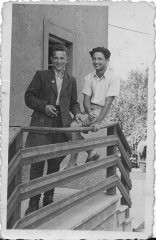You searched for: poland
<< Previous | Displaying results 1051-1100 of 1569 for "poland" | Next >>
-
Laks family photo
PhotoLaks family photo, Poland, ca. 1925. Sitting, left to right: Pola Laks (Regina's mother) with baby Hania, grandmother Sara Tennenblum, Aunt Andzia Tennenblum. Standing, left to right: Aunt Lodzia Laks, Aunt Regina Tennenblum, Izak Laks (Regina's father), Aunt Rozia Tennenblum, and Aunt Dora Laks.

-
2004 portrait of Regina (Laks) Gelb
PhotoBorn as Regina Laks in 1929, she was raised in Starachowice, an industrial city in central Poland. Her mother, Pola Tennenblum, was an active member of the Zionist movement. Her father, Isaac Laks, was an engineer in the lumber industry. She had two older sisters.

-
Rut Berlinska
ArticleChildren's diaries bear witness to some of the most heartbreaking experiences of the Holocaust. Learn about the diary and experiences of Rut Berlinska.
-
Operation "Harvest Festival"
ArticleLearn about Operation “Harvest Festival” (Aktion “Erntefest”), the Nazi attack against the remaining Jews of the Lublin District of the General Government.

-
Janowska
ArticleIn 1941, the Nazis established Janowska camp. It was primarily used as a forced-labor and transit camp.
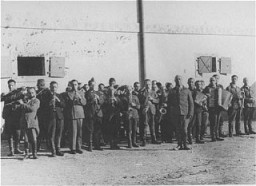
-
Luxembourg
ArticleBefore WWII, over 3,500 Jews lived in Luxembourg. Under the German occupation, this community was almost completely destroyed. Learn more.
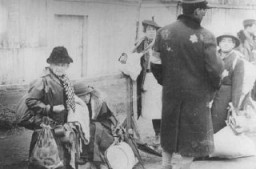
-
Mechelen
ArticleThe Mechelen camp, halfway between Antwerp and Brussels, was a transit camp for the deportation of Jews from Belgium during the Holocaust.

-
Deadly Medicine: Irmgard Huber
ArticleIrmgard Huber was head nurse of the facility at Hadamar, one of 6 major "euthanasia" killing centers in Nazi Germany. Learn more about her role.

-
Salzburg Displaced Persons Camps
ArticleAfter WWII, many Holocaust survivors, unable to return to their homes, lived in displaced persons camps in Germany, Austria, and Italy. Read about Salzburg DP camp.

-
Düppel Center Displaced Persons Camp
ArticleAfter WWII, many Holocaust survivors, unable to return to their homes, lived in displaced persons camps in Germany, Austria, and Italy. Read about Düppel Center DP camp.

-
Lindenfels Displaced Persons Camp
ArticleAfter WWII, many Holocaust survivors, unable to return to their homes, lived in displaced persons camps in Germany, Austria, and Italy. Read about Lindenfels DP camp.
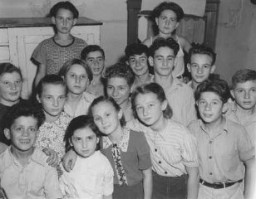
-
Walter Marx
ArticleRead the Jewish Partisan Educational Foundation's short biography of Walter Marx.
-
Page from the Stroop Report
PhotoA page from SS officer Juergen Stroop's report on the Warsaw ghetto uprising. He wrote: "This is what the former Jewish residential quarter looks like after its destruction." Warsaw, Poland, April-May, 1943.

-
Underground bunker in Warsaw
PhotoAn underground bunker, built by Jews in Warsaw in preparation for anti-Nazi resistance. This photograph shows cooking facilities in a bunker. Jews hid in bunkers while the Germans systematically destroyed the ghetto during the uprising. Warsaw, Poland, April 19–May 16, 1943.

-
Memorial service in Warsaw
PhotoAdolf Berman speaks at a memorial service commemorating the Warsaw ghetto uprising. The building in the background, destroyed during the 1943 uprising, held the office of the Jewish council. Warsaw, Poland, 1945. During the German occupation, Berman was active in the Jewish underground and played a leadership role in the Council for Aid to Jews, known as Zegota.
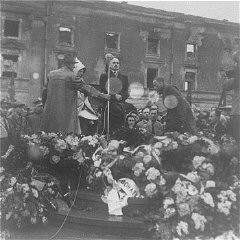
-
Refugee camp in Zbaszyn
PhotoView of Zbaszyn, the site of a refugee camp for Jews of Polish nationality who were expelled from Germany. The Jewish refugees, hungry and cold, were stranded on the border, denied admission into Poland after their expulsion from Germany. Photograph taken between October 28, 1938, and August 1939. Warsaw-based historian, political activist, and social welfare worker Emanuel Ringelblum spent five weeks in Zbaszyn, organizing assistance for the refugees trapped on the border.
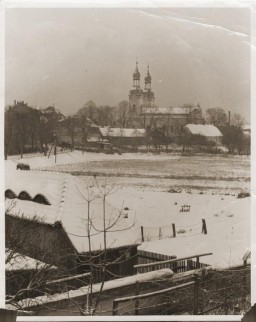
-
View of the refugee camp in Zbaszyn
PhotoView of the flour mill in Zbaszyn, which served as a refugee camp for Jews expelled from Germany. The Jewish refugees, hungry and cold, were stranded on the border, denied admission into Poland after their explusion from Germany. Photograph taken between October 28, 1938, and August 1939. Warsaw-based historian, political activist, and social welfare worker Emanuel Ringelblum spent five weeks in Zbaszyn, organizing assistance for the refugees trapped on the border.

-
Identification card issued to Oskar Russ in the Feldafing displaced persons' camp
PhotoIdentification card issued to Oskar Russ in the Feldafing displaced persons' camp. Oskar Russ was born in Poland in 1907. During the Holocaust, he was imprisoned in the Dachau concentration camp. After liberation, he was in the Feldafing displaced persons camp before immigrating in 1947 to the United States with his wife (whom he had married in Feldafing).
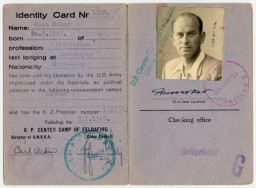
-
The "Final Solution"
SeriesThe Nazi “Final Solution to the Jewish Question” was the deliberate, planned mass murder of European Jews. Learn more about how the Nazis implemented the "Final Solution."
-
Young Diarists from the Lodz Ghetto
SeriesThe Jewish children of Lodz suffered unfolding harsh realities after the German invasion of Poland. Some of them, including Dawid Sierakowiak, recorded their experiences in diaries.
-
Life After the Holocaust: Regina Gelb
ArticleAfter WWII and the fall of the Nazi regime, Holocaust survivors faced the daunting task of rebuilding their lives. Listen to Regina Gelb's story.

-
Meyer (Max) Rodriguez Garcia: Maps
Media EssayMeyer (Max) Rodriguez Garcia was born to a Jewish family in Amsterdam. Max was nearly 16 years old when Germany invaded the Netherlands in May 1940. He went into hiding in early 1943, but was caught by June and deported to Auschwitz in German-occu...
-
Hand-drawn plan of Westerbork transit camp
DocumentThe Dutch government established a camp at Westerbork to intern Jewish refugees who had entered the Netherlands illegally. This sketch of the Westerbork transit camp was made by a Jewish inmate who was able to emigrate to the United States. In early 1942, the German occupation authorities decided to enlarge Westerbork and convert it into a transit camp for Jews. The systematic concentration of Jews from the Netherlands in Westerbork began in July 1942. From Westerbork, Jews were deported to the killing…
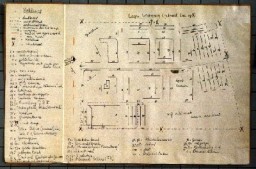
-
Aron and Lisa Derman: Oral History Excerpts
Media EssayIn 1942, Aron Derman and Lisa Nussbaum escaped deportation from the Grodno ghetto with the help of Tadek Soroka, a non-Jewish Pole. Aron and Lisa—aged 19 and 15—joined the armed Jewish resistance. As partisans, they f...
-
Chiune Sugihara
Media EssayChiune (Sempo) Sugihara (January 1, 1900-1986) was the first Japanese diplomat posted to Lithu...

-
Soviet military advance in Vitebsk
FilmThe Germans invaded the Soviet Union in June 1941 (Operation "Barbarossa"). German forces occupied Vitebsk in the northeastern region of Belorussia on July 11. Soviet forces seized the initiative from the Germans after the battle of Stalingrad in late 1942 and early 1943. The Soviet army liberated Vitebsk on June 26, 1944, during their summer 1944 offensive. This footage shows military units involved in the fighting and German soldiers captured during the campaign. By the end of the summer, the Soviet…
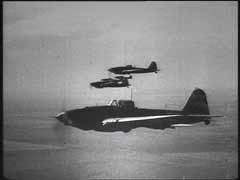
-
Romani (Gypsy) campsite near Berlin
FilmThis film excerpt from Groß-Stadt Zigeuner (1932) by filmmaker László Moholy-Nagy shows a Romani (Gypsy) campsite near Berlin, Germany, in the last year of the Weimar Republic. Although Roma (Gypsies) had faced persecution in Germany even before the Nazi rise to power in 1933, the Nazis regarded them as racial enemies to be identified and killed. Tens of thousands of Roma were killed by the Einsatzgruppen in eastern Europe or were deported to killing centers in occupied Poland.
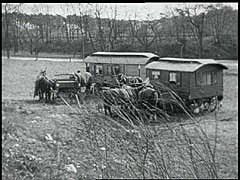
-
Family portrait in Munkacs
PhotoPortrait of the Ehrlich family seated around the family table. Munkacs, Czechoslovakia, 1930. Among those pictured is Elizabeth Ehrlich (later Roth) standing in the middle of the back row in a light dress, and Rella Ehrlich (front row, second from the right). Elizabeth was born in Munkacs. In 1944 she was confined to the ghetto there before being deported with her family to Auschwitz. She was later transferred to a camp in Bydogszcz, Poland, and from there to the Stutthof concentration camp.
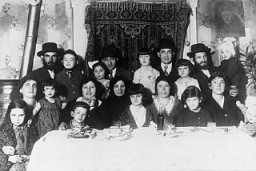
-
Hidden child Gitta Rosenzweig
PhotoDuring a roundup for deportation in eastern Poland in 1942, Gitta Rosenzweig—then three or four years old—was sent into hiding. She ended up in a Catholic orphanage. In 1946, Ida Rosenshtein, a family friend and a survivor, learned of the child's whereabouts and sought to claim her. After denying that it held a Jewish child, the orphanage relinquished custody after Ida recognized Gitta and a local Jewish committee paid a "redemption" fee. Gitta is pictured here on the day she left the orphanage.
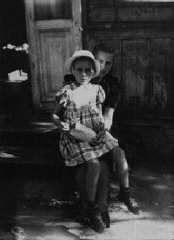
-
Arrival of Hungarian Jews at Auschwitz
PhotoA transport of Hungarian Jews lines up on the ramp for selection at the Auschwitz-Birkenau killing center in German-occupied Poland. May 1944. In mid-May 1944, the Hungarian authorities, in coordination with the German Security Police, began to systematically deport the Hungarian Jews. SS Colonel Adolf Eichmann was chief of the team of "deportation experts" that worked with the Hungarian authorities. The Hungarian police carried out the roundups and forced the Jews onto the deportation trains. In…
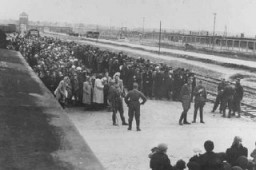
-
Barbed-wire fence separating the Krakow ghetto from the rest of the city
PhotoView of a barbed-wire fence separating part of the ghetto in Krakow from the rest of the city. Krakow, Poland, date uncertain. During the Holocaust, the creation of ghettos was a key step in the Nazi process of brutally separating, persecuting, and ultimately destroying Europe's Jews. Ghettos were often enclosed districts that isolated Jews from the non-Jewish population and from other Jewish communities.
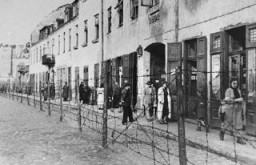
-
Berlin environs, 1942
MapBerlin was a center of Jewish life in Germany and—as the capital of the Reich—also the center for the planning of the "Final Solution," the decision to kill the Jews of Europe. The Wannsee Conference, named for the resort district in southwestern Berlin where it was held, took place in January 1942. High-ranking officials from the Nazi party, the SS, and the German state met to coordinate and finalize what they referred to as the "final solution to the Jewish problem." At the conference, these…

-
Miles Lerman describes the value of weapons
Oral HistoryMiles Lerman was a Holocaust survivor, partisan fighter in the forests of Poland, international leader in the cause of Holocaust remembrance, and a "founding father" of the United States Holocaust Memorial Museum.
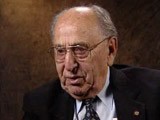
-
Norman Salsitz and Amalie Petranka shortly after they met
PhotoNorman Salsitz and Amalie Petranka shortly after they met (under their assumed identities of, respectively, Felicja Milaszewska and Tadeusz Zaleski). Krakow, Poland, March 15, 1945. With the end of World War II and collapse of the Nazi regime, survivors of the Holocaust faced the daunting task of rebuilding their lives. With little in the way of financial resources and few, if any, surviving family members, most eventually emigrated from Europe to start their lives again. Between 1945 and 1952, more than…

-
Portrait of Aron's family on his mother's side
PhotoPortrait of Aron's family on his mother's side, taken when Aron's cousin moved to Israel in 1933-1934. Aron is seated second from left, bottom row. His mother, Miriam, is in the center row, second from right. Aron's father is behind her and to her right. Aron himself was 8 or 9 years old when this picture was taken in either May or June. At the time, Aron recalled, "I was thinking about going to summer camp." Slonim, Poland, 1933-1934.
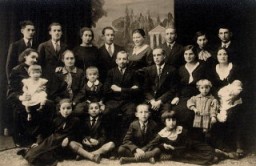
-
2005 portrait of Aron Derman
PhotoAron was born to a middle-class Jewish family in Slonim, a part of Poland between the two world wars. His parents owned a clothing store. After studying in a technical school, Aron worked as a motion-picture projectionist in a small town near Slonim. The Soviet army took over Slonim in September 1939. War broke out between Germany and the Soviet Union in June 1941. Aron returned to Slonim. The Germans soon occupied Slonim, and later forced the Jews into a ghetto.
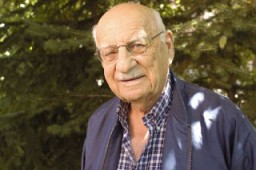
-
Thomas Buergenthal at Auschwitz in 1995
PhotoThomas Buergenthal at Auschwitz in 1995, fifty years to the day after his forced march out of the camp as a child. Poland, 1995. With the end of World War II and collapse of the Nazi regime, survivors of the Holocaust faced the daunting task of rebuilding their lives. With little in the way of financial resources and few, if any, surviving family members, most eventually emigrated from Europe to start their lives again. Between 1945 and 1952, more than 80,000 Holocaust survivors immigrated to the United…
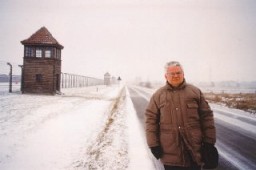
-
The Holocaust in Subcarpathian Rus and Southern Slovakia
ArticleLearn more about the history of the Transcarpathian region of Ukraine (historically known as Subcarpathian Rus) during World War II.

-
Gurs
ArticleIn 1939, the French government established the Gurs camp. Learn more about the history of the camp before and after the German invasion of France.
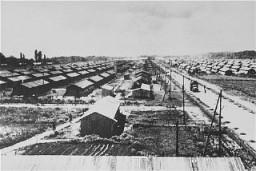
-
Belgium
ArticleThe Germans conquered Belgium in May 1940. Learn about the occupation, anti-Jewish laws and ordinances, detention camps, and deportations of Jews from Belgium.

-
Amsterdam
ArticleLearn about Amsterdam during World War II and the Holocaust, including deportations of Jews to concentration camps and killing centers.
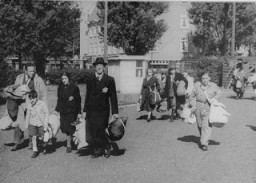
-
Blitzkrieg (Lightning War)
ArticleBlitzkrieg, meaning "Lightning War" in German, was Germany’s strategy to avoid a long war in the first phase of World War II in Europe.
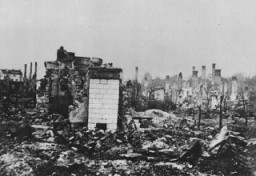
-
Writers and Poets in the Ghettos
ArticleSongs, verses, and writings of writers and poets in the ghettos reflect efforts to preserve culture, humanity, and documentation, as well as acts of defiance. Explore examples.
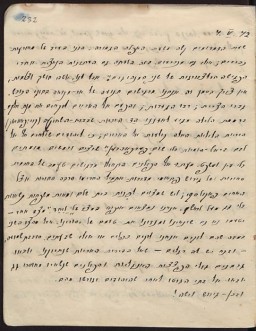
-
Sephardi Jews during the Holocaust
ArticleLearn about the fate of Sephardi Jewish communities during the Holocaust. On the eve of WWII, Europe's Sephardi Jews lived mostly in the Balkan countries.
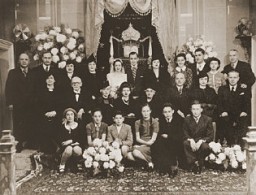
-
Wöbbelin
ArticleThe US 8th Infantry and the 82nd Airborne Divisions arrived at the Wöbbelin camp in May 1945, witnessing the deplorable living conditions in this subcamp of the Neuengamme concentration camp.

-
Sachsenhausen: Key Dates
ArticleKey dates in the history of the Sachsenhausen camp in the Nazi camp system, from its establishment in 1936 to the postwar trial of camp staff in 1947.

-
Dora Oltulski
ArticleRead the Jewish Partisan Educational Foundation's short biography of Dora Oltulski.

-
Norman Salsitz
ArticleRead the Jewish Partisan Educational Foundation's short biography of Norman Salsitz.
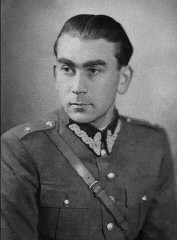
-
Brenda Senders
ArticleRead the Jewish Partisan Educational Foundation's short biography of Brenda Senders.

-
Leon Senders
ArticleRead the Jewish Partisan Educational Foundation's short biography of Leon Senders.
